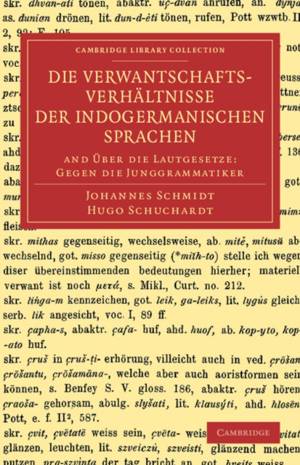
- Afhalen na 1 uur in een winkel met voorraad
- Gratis thuislevering in België vanaf € 30
- Ruim aanbod met 7 miljoen producten
- Afhalen na 1 uur in een winkel met voorraad
- Gratis thuislevering in België vanaf € 30
- Ruim aanbod met 7 miljoen producten
Zoeken
Die Verwantschaftsverhaltnisse Der Indogermanischen Sprachen
Johannes Schmidt, Carl Schuchardt, Hugo Schuchardt
€ 54,95
+ 109 punten
Omschrijving
The German linguists Johannes Schmidt (1843-1901) and Hugo Schuchardt (1842-1927) sought to answer many questions relating to the development of Indo-European languages, which are all believed to be descended from a single common ancestor. Schmidt's Verwantschaftsverhältnisse was originally published in 1872 and Schuchardt's Über die Lautgesetze followed in 1885; here they are reissued together in one volume. Schmidt's work developed the 'wave model' of language change, to which Schuchardt also subscribed. According to this theory, linguistic innovations spread outwards concentrically like waves, which become progressively weaker as time elapses and the distance from their point of origin increases. Since later changes may not cover the same area, there may be no sharp boundaries between neighbouring languages or dialects. This theory stood in opposition to the tree model and the doctrine of sound laws propounded by the Neogrammarian school of linguists, which is roundly critiqued in Schuchardt's contribution.
Specificaties
Betrokkenen
- Auteur(s):
- Uitgeverij:
Inhoud
- Aantal bladzijden:
- 122
- Taal:
- Engels
- Reeks:
Eigenschappen
- Productcode (EAN):
- 9781108062947
- Verschijningsdatum:
- 24/10/2013
- Uitvoering:
- Paperback
- Formaat:
- Trade paperback (VS)
- Afmetingen:
- 140 mm x 216 mm
- Gewicht:
- 163 g

Alleen bij Standaard Boekhandel
+ 109 punten op je klantenkaart van Standaard Boekhandel
Beoordelingen
We publiceren alleen reviews die voldoen aan de voorwaarden voor reviews. Bekijk onze voorwaarden voor reviews.








